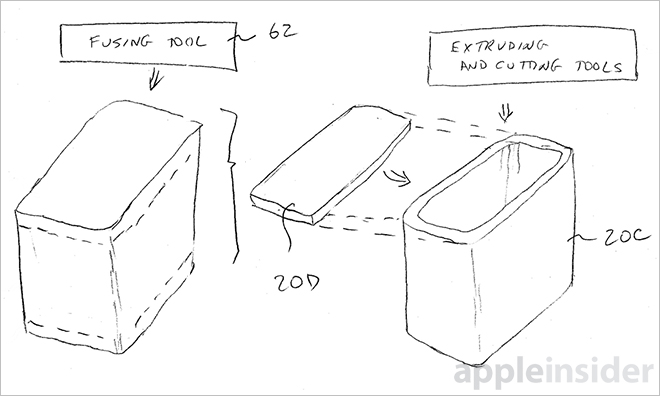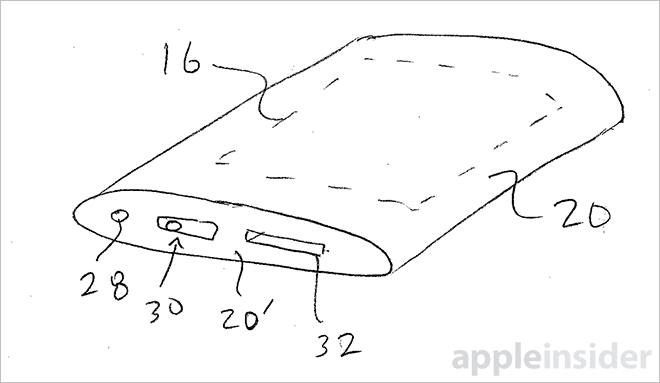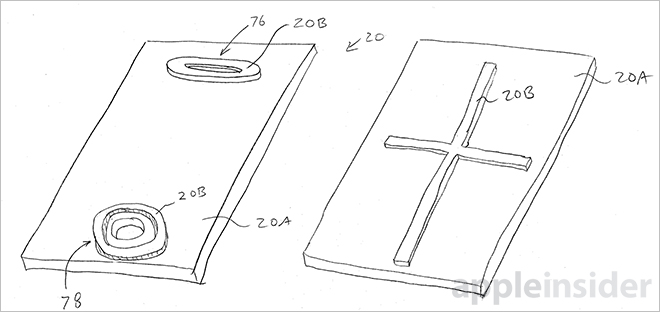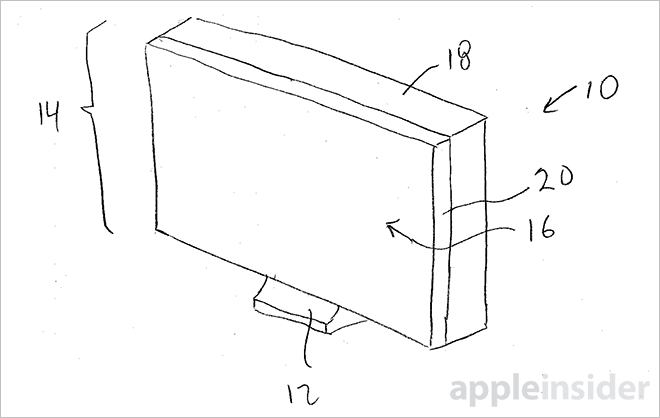Apple on Monday was granted a U.S. patent covering a method of fusing glass structures together to encapsulate the internal circuitry of an iOS device, and that of larger electronics like monitors and televisions.
The U.S. Patent and Trademark Office awarded Apple U.S. Patent No. 8,773,848 for "Fused glass device housings," which describes a procedure that allows for the efficient fabrication of seamless all-glass electronic device casings.
As noted by Apple, all-glass structures can be heavy, especially if the material is layered to protect against scratches, drops and other accidental damage. The company proposes a new construction method that ensures durability, a lightweight design and eye-pleasing aesthetics.
Instead of using a completely glass-on-glass build, Apple suggests joining glass pieces together via a fusing process. According to the patent, the edges of planar and peripheral glass members can be fused together to form a sufficiently thick piece of material that may be machined down to a desired shape. For example, the illustration below shows a media player with rounded edges and flexible display.
To bolster the casing's structural integrity, raised glass features can be fused to the planar member at weak points in the build. Examples include the addition of glass structures around holes or openings in the glass member, as well as internal support ribs placed that reduce flexing and breakage. Cutouts in the glass surface can serve as holes for buttons and other physical device controls.
In some embodiments, glass members are fused together to create a five-sided box in which displays, circuitry and other internal components can be inserted, or "slid into place." This is especially crucial for larger applications like televisions or monitors that are mounted on stands.
The back portion — side opposite that of the display — can be tinted a translucent color or made opaque to hide unsightly batteries, chips and flex cables, though Apple leaves an option to keep all sides transparent. Portions of planar glass members may be "roughened" to help scatter and diffuse light around display edges.
Once the internals are inserted, an end cap is placed over the opening to seal off the structure from debris and other contaminants.
Finally, the patent goes into detail on polishing and glass strengthening techniques, as well as alternative embodiments that involve extruded hollow glass rods with fused end caps. Additional attention is paid to glass fusing methods that reduce frit to leave seamless joints.
With Apple's latest iOS device designs, it appears the company is moving further away from the "glass sandwich" aesthetic introduced with the iPhone 4. Combined with rumors of sapphire crystal adoption over Gorilla Glass, the patented glass fusing technology may never make its way to the consumer market. Then again, Apple does hold patents for sapphire lamination and fusion technology that could work well with today's granted IP.
Apple's seamless fused glass housing patent was first filed for in 2013 and credits Peter Russell-Clarke, Michael K. Pilliod and SVP of Design Jony Ive as its inventors.
 Mikey Campbell
Mikey Campbell










-m.jpg)






 Marko Zivkovic
Marko Zivkovic
 Mike Wuerthele
Mike Wuerthele
 Christine McKee
Christine McKee
 Amber Neely
Amber Neely
 Sponsored Content
Sponsored Content
 Wesley Hilliard
Wesley Hilliard

 William Gallagher
William Gallagher









32 Comments
This all makes perfect sense. If you believe the leaks on youtube re the iPhone 6 sapphire display it is strong, flexible and scratch proof. Why not then cover the whole device with sapphire. If you add wireless charging, bluetooth connectivity for headphones and magnetically coupled speakers/microphones (or at least internal vented ones so that they are sealed to the outside) then you could have a completely sealed smooth unit - very Jonny Ive! You could still have a lightning port as that can be sealed from the device, but ultimately I see Apple doing away with all external connections in order to make the phone a completely sealed monolithic slab. This would look/ feel very classy and be incredibly durable.
Apple is being very strategically clever here. By developing materials that other manufacturers will find it very hard o impossible to copy at a reasonable cost or in a reasonable timeframe they are playing to their strengths. How will a plastic backed Samsung S6/7 look compared to an all sapphire iPhone? The rumoured updated S5 with a metal band around it probably won't have a metal back as where would they put the antenna? The iPhone 5s manages it only with a lot of internal engineering, way beyond what Samsung is likely to do for a midcylce upgrade of the S5. So even in the short term you are likely to see a Galaxy S5 with a metal chamfered band around it and a plastic (fake metalled?) back competing with a larger iPhone 6 with curved sapphire display - no wonder people are getting more bullish about the Apple product cycle!
Apple cannot win by competing on price. They can win by competing on style, marketing, engineering, integration and functionality.
style: thinner curvy sapphire coated iphone
marketing: expanded retail presence, Angela Ahrendts & other top level hires, lower the cost of entry to encourage expansion of the ecosystem with a cheaper iMac, iPod touch and MacBook Air
engineering new materials such as detailed above (+liquidmetal?). Cornering the market in sapphire to gain a competitive edge
vertical integration (iCloud Drive, Homekit, Healthkit, Webkit, Photos in the cloud, iMessage audio/video, Handoff)
IOS 8, swift, metal, touch ID
It seems to me TC has the same Apple laser focus as his predecessor and his bodes very well
I would love an all-Sapphire curved edge iPhone! This would look so cool. And there would be nothing blocking the antenna inside. And it would look luxurious, expensive, jewelry-like, hot and cool. Apple an also simply paint the inside of the back sapphire panel if you don't want to see the interior electronics - you can get the interior color in multiple colors as well.
Would this patent cover a sapphire all-around case? I like the dreaming shared above. But this patent seems focused on glass. That said, maybe it's part of a bigger plan. I've noticed over time that Apple seek to have all their products match aesthetically. It first occurred to me when the white plastic iMacs came out. I thought, It looks like a giant iPod, which at the time were white polycarbonate. So how about this: maybe the new aesthetic will be encased transparents. IWatch and iPhone will be encased sapphire (with liquidmetal?), and the larger devices will be encased glass with aluminum. ... Sounds like the future if you ask me.
I like this idea very much.
Imagine a glass iMac with no hard drive or ports to make it even thinner, but using Wi-Fi and Bluetooth to connect to USB devices and external Hard Drive devices.
According to the patent, the edges of planar and peripheral glass members can be fused together to form a sufficiently thick piece of material that may be machined down to a desired shape.
...
In some embodiments, glass members are fused together to create a five-sided box in which displays, circuitry and other internal components can be inserted, or "slid into place."
...
The back portion -- side opposite that of the display -- can be tinted a translucent color or made opaque to hide unsightly batteries, chips and flex cables, though Apple leaves an option to keep all sides transparent. Portions of planar glass members may be "roughened" to help scatter and diffuse light around display edges.
...
Once the internals are inserted, an end cap is placed over the opening to seal off the structure from debris and other contaminants.
...
Finally, the patent goes into detail on polishing and glass strengthening techniques, as well as alternative embodiments that involve extruded hollow glass rods with fused end caps. Additional attention is paid to glass fusing methods that reduce frit to leave seamless joints.
I know the patent describes an iMac type of device, but to me it screams of the possible construction of the so-called iWatch. The device can be completely sealed by glass, and the glass can be colored/tinted/diffused. If this were made of sapphire...
Such a device would be perfect for a fitness watch (no worries about water or sweat) or even a high-end "smartwatch" (I hate that term but cannot think of any other alternative). Of course, it would be charged by induction.
Samsung could not possibly copy this within a few product generations.